Cleveland, Ohio Blood Testing Facilities
 Represents a LabCorp blood testing facility
Represents a LabCorp blood testing facility Represents a Quest Diagnostics blood testing facility
Represents a Quest Diagnostics blood testing facility
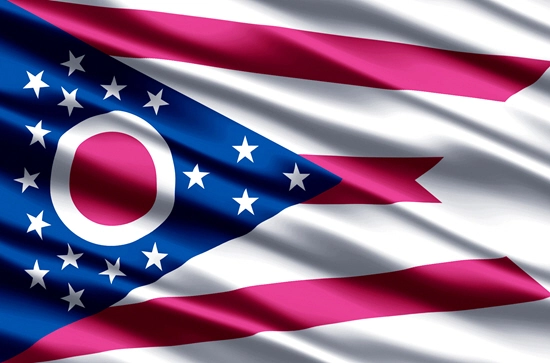
Nearby Labcorp Blood Testing facilities:
- Labcorp Center Distance: 7 m, 5 Severance Circle Ste 210, Cleveland Heights, Cuyahoga County, OH, 44118
- Labcorp Center Distance: 8 m, 6789 Ridge Rd Ste 210, Parma, Cuyahoga County, OH, 44129
- Labcorp Center Distance: 14 m, 35040 Chardon Rd Ste G300, Willoughby, Lake County, OH, 44094
- Labcorp Center Distance: 22 m, 418 E Broad St, Elyria, Lorain County, OH, 44035
- Labcorp Center Distance: 25 m, 4482 Darrow Rd, Stow, Summit County, OH, 44224
- Labcorp Center Distance: 26 m, 2269 Cooper Foster Park Rd F, Amherst, Lorain County, OH, 44001
- Labcorp Center Distance: 27 m, 1 Park West Blvd Ste 290, Akron, Summit County, OH, 44320
- Labcorp Center Distance: 46 m, 4152 Holiday St Nw, Canton, Stark County, OH, 44718
- Labcorp Center Distance: 50 m, 272 Benedict Ave, Norwalk, Huron County, OH, 44857
- Labcorp Center Distance: 51 m, 3921 E Market St Ste 3, Warren, Trumbull County, OH, 44484
- Labcorp Center Distance: 64 m, 8170 South Ave Ste 3 Bldg C, Boardman, Mahoning County, OH, 44512
- Labcorp Center Distance: 68 m, 564 S Trimble Rd Ste B, Mansfield, Richland County, OH, 44906
- Labcorp Center Distance: 69 m, 897 E Iron Ave, Dover, Tuscarawas County, OH, 44622
- Labcorp Center Distance: 70 m, 125 Canton Rd Nw, Carrollton, Carroll County, OH, 44615
- Labcorp Center Distance: 75 m, 179 Enclave Drive, New Castle, Lawrence County, PA, 16105
- Labcorp Center Distance: 82 m, 1151 Washington Street, Newell, Hancock County, WV, 26050
- Labcorp Center Distance: 92 m, 200 Luray Drive, Wintersville, Jefferson County, OH, 43953
- Labcorp Center Distance: 93 m, 300 State Street Suite 303, Erie, Erie County, PA, 16507
- Labcorp Center Distance: 94 m, 3136 West Street, Weirton, Hancock County, WV, 26062
- Labcorp Center Distance: 97 m, 5250 Auto Club Dr Ste 310A, Dearborn, Wayne County, MI, 48126
- Labcorp Center Distance: 99 m, 1565 S Byrne Rd Ste 105, Toledo, Lucas County, OH, 43614
Nearby Quest Blood Testing facilities:
- Quest Center Distance: 8 m, 7451 West Ridgewood Dr, Parma, Cuyahoga County, OH, 44129-5534
- Quest Center Distance: 11 m, 18660 Bagley Rd, Middleburg Heights, Cuyahoga County, OH, 44130-3483
- Quest Center Distance: 15 m, 33790 Bainbridge Rd, Solon, Cuyahoga County, OH, 44139-2947
- Quest Center Distance: 19 m, 2451 Edison Blvd, Twinsburg, Summit County, OH, 44087-2340
- Quest Center Distance: 23 m, 9213 Mentor Ave, Mentor, Lake County, OH, 44060-6477
- Quest Center Distance: 24 m, 605 North Cleveland Massillon Rd, Akron, Summit County, OH, 44333-2241
- Quest Center Distance: 28 m, 462 Howe Ave, Cuyahoga Falls, Summit County, OH, 44221-3002
- Quest Center Distance: 38 m, 3479 Massillon Rd, Uniontown, Summit County, OH, 44685-7823
- Quest Center Distance: 47 m, 4638 Hills And Dales Rd Northwest, Canton, Stark County, OH, 44708-1510
- Quest Center Distance: 53 m, 2500 West Strub Rd, Sandusky, Erie County, OH, 44870-5366
- Quest Center Distance: 55 m, 6006 Mahoning Ave, Austintown, Mahoning County, OH, 44515-2239
- Quest Center Distance: 63 m, 7629 Market St, Youngstown, Mahoning County, OH, 44512-6054
- Quest Center Distance: 64 m, 9471 Market St, North Lima, Mahoning County, OH, 44452-8702
- Quest Center Distance: 65 m, 869 E State St, Sharon, Mercer County, PA, 16146-3341
- Quest Center Distance: 67 m, 339 Cline Ave, Mansfield, Richland County, OH, 44903-1072
- Quest Center Distance: 68 m, 107 Royal Birkdale Dr, Columbiana, Columbiana County, OH, 44408-8493
- Quest Center Distance: 76 m, 2004 W State St, New Castle, Lawrence County, PA, 16101-1248
- Quest Center Distance: 80 m, 1700 New Butler Road Giant Eagle Plaza, New Castle, Lawrence County, PA, 16101-3119
- Quest Center Distance: 85 m, 448 Erie Street, Edinboro, Erie County, PA, 16412-2294
- Quest Center Distance: 88 m, 4247 West Ridge Rd, Erie, Erie County, PA, 16506-1718
- Quest Center Distance: 89 m, 14720 King Rd, Riverview, Wayne County, MI, 48193-7973
- Quest Center Distance: 90 m, 2501 West 12Th Street, Erie, Erie County, PA, 16505-4527
- Quest Center Distance: 91 m, 7200 Peach St, Erie, Erie County, PA, 16509-4754
- Quest Center Distance: 92 m, 1046 N Monroe St, Monroe, Monroe County, MI, 48162-2936
- Quest Center Distance: 93 m, 1526 Peach St, Erie, Erie County, PA, 16501-2110
- Quest Center Distance: 94 m, 350 East Bayfront Parkway, Erie, Erie County, PA, 16507-2410
- Quest Center Distance: 96 m, 26400 Van Dyke Ave, Center Line, Macomb County, MI, 48015-1216
- Quest Center Distance: 98 m, 25070 Michigan Ave, Dearborn, Wayne County, MI, 48124-1740
- Quest Center Distance: 99 m, 20325 Route 19N, Cranberry Twp, Butler County, PA, 16066-6019
Cleveland Hormone Replacement Therapy Services
Have you ever considered HRT Therapy with HGH, Testosterone, or other forms of Hormone Treatments? Well, you've come to the right place. The Conscious Evolution Institute is Cleveland's best source for quality Hormone Therapy and Optimization Options provided by a board-certified and licensed Hormone Clinic. We operate all throughout the Cleveland area, with the help of our medical affiliates which work with us to provide you with the best possible services.
Aside from the city itself, we also serve the entire Cleveland metropolitan area, and every county in the state of Ohio. Suburbs that our clinic serves include in Cleveland Heights, Garfield Heights, Lakewood, Rocky River, Bay Village, and Fairview Park. If you feel that your health has been suffering as a result of Hormone Deficiency, HRT Treatments may be the key to improving and enhancing your health. If you've ever thought about the benefits of Hormone Replacement Therapy, we strongly urge you to contact us by phone or using the form on this very page!
Cleveland Growth Hormone HGH Injection Therapy for Hypopituitarism
One of the many Hormone Optimization Solutions that we offer to Cleveland at the Conscious Evolution Institute is Human Growth Hormone Replacement Therapy. HGH is among the most important hormones produced by the body, and is the key to keeping the organs and systems of the body functioning at peak capacity. The big problem is that our bodies slowly start producing less and less of the hormone after the age of thirty, leading to an eventual decline in quality of life and health status as the decline becomes more severe.
Our clinic offers the people of Cleveland the best HGH Injection Treatments available, including Nutropin, Humatrope, and Omnitrope Name Brand Human Growth Hormone. HGH Deficiency suppresses health in a wide variety of ways, including unhealthy changes in body composition, depression, lack of energy, diminished libido, foggy memory, increased susceptibility to illness, trouble healing, and increased appearance of lines, wrinkles, and other signs of skin damage. If you are interested in Cleveland, Ohio Growth Hormone Therapy, give us a call!
Cleveland Injectable Sermorelin Acetate Therapy
Along with HGH Therapy Injections, our Licensed Cleveland HRT Clinic also offers a product known as Sermorelin Acetate, which has been clinically shown to be equally as effective as HGH, and perhaps even more so, for patients suffering from Clinical HGH Deficiency. Sermorelin works because it stimulates your own pituitary to start making more Growth Hormone.
Another advantage is that the body has mechanisms in place to prevent the pituitary from producing too much HGH, which means that Sermorelin functionally causes the body to produce as much as it needs to optimize health and wellness. Our Cleveland Hormone Clinic is one of the premier providers of this Revolutionary Hormone Treatment in the state of Ohio. It's cheaper than HGH and can be prescribed off-label, which makes it a fantastic option for patients with Age-Related HGH Deficiency
Cleveland Low-T Bio-Identical Testosterone Treatments
Testosterone Deficiency affects tens of thousands of men in the state of Ohio, and, unfortunately, far too many never reach out for the treatment that they need and deserve. If you've experienced changes in your sexual health, including erectile dysfunction, a lack of sexual desire and/or premature ejaculation, these are all signs that you may be in need of the Cleveland Testosterone Therapy Services that we offer. We provide a variety of quality Testosterone products to Ohio residents, including Androgel, Androderm, Axiron, and Testosterone Cypionate.
In addition to romantic issues associated with Low-T, Testosterone Deficiency is also characterized by a number of other changes which can negatively impact your wellness, such as poor cholesterol, hypertension, atherosclerosis, obesity, diabetes, anxiety, and lack of confidence. Let us boost your Testosterone Levels and restore your vitality with Cleveland Testosterone Creams, Patches, or Injections. Just give our Hormone Clinic a call to speak with a representative!
Cleveland Injectable HCG Diet Treatments
Have you struggled with dieting in the past? Are you currently overweight or obese, and are looking for a Cleveland Weight Loss Plan that fits your needs? One of the great Hormone Programs that we offer at the Conscious Evolution Institute is HCG Therapy for Weight Loss. We use a specialized therapy regimen which combined Bio-Identical HCG with Caloric Restriction to promote truly life-changing weight loss, which can help you discover a fitter and trimmer you just over the course of one to three months.
With this special diet plan, patients have lost as a pound per day for a month, without feeling hungry or tired. It works because it increases your body's fat burning potential while supporting muscle mass, while also actively working to eliminate the hunger pangs normally caused by such strict dieting. With just a single phone call, we can help you put off the pounds with our certified Cleveland Diet Treatment!
Cleveland, Ohio Information
Cleveland is the second most populous city in the state of Ohio, behind only Columbus, Ohio, though Cleveland is the largest metropolitan in Ohio, a highly populated region which includes Canton and Akron. The city is situated on the southern shore of Lake Erie, and is located just an hour or so from the Pennsylvania border. Cleveland is the main city located in Cuyahoga County, and acts as the seat of the county.
Cleveland was first settled around 1662, actually as part of the Connecticut colony. Over a century later, Cleveland would become a city, and was named after a man named General Cleaveland, who was the Brigadier General of the Connecticut Militia. In 1836, Cleveland was officially incorporated. The city became an important industrial town starting in the mid-19th century, when the Erie Canal and the Ohio Canal opened the area up for trade by water. During the Civil War, the city experienced explosive economic growth to feed the Union Army with the materials that it needed to fight and win the war.
Today, as most larger cities in the United States have done, the Cleveland economy has greatly diversified, and is now heavily involved in finance, banking, utilities, retail, insurance, and transportation. Cleveland is home to many professional sports outfits, including the Cleveland Indians, the Cleveland Cavaliers, and the Cleveland Browns.
All About Cleveland, Ohio Geographic Area
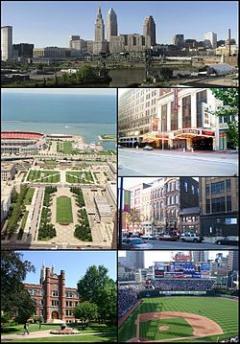
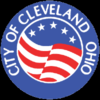
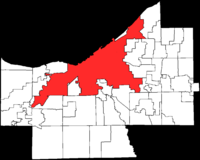
Cleveland ( /ËnkliËavlÉond/) is a city in the U.S. state of Ohio and is the county seat of Cuyahoga County, the most populous county in the state. The city is located in northeastern Ohio on the southern shore of Lake Erie, approximately 60 miles (97 km) west of the Pennsylvania border. It was founded in 1796 near the mouth of the Cuyahoga River, and became a manufacturing center owing to its location on the lake shore, as well as being connected to numerous canals and railroad lines. Cleveland's economy has diversified sectors that include manufacturing, financial services, healthcare, and biomedical. Cleveland is home to the Rock and Roll Hall of Fame.
/ËnkliËavlÉond/) is a city in the U.S. state of Ohio and is the county seat of Cuyahoga County, the most populous county in the state. The city is located in northeastern Ohio on the southern shore of Lake Erie, approximately 60 miles (97 km) west of the Pennsylvania border. It was founded in 1796 near the mouth of the Cuyahoga River, and became a manufacturing center owing to its location on the lake shore, as well as being connected to numerous canals and railroad lines. Cleveland's economy has diversified sectors that include manufacturing, financial services, healthcare, and biomedical. Cleveland is home to the Rock and Roll Hall of Fame.
As of the 2010 Census, the city proper had a total population of 396,815, making Cleveland the 45th largest city in the United States, and the second largest city in Ohio. Greater Cleveland, the Cleveland-Elyria-Mentor Metropolitan Statistical Area, ranked 28th largest in the United States with 2,068,283 people in 2011. Cleveland is part of the larger Cleveland-Akron-Elyria Combined Statistical Area, which in 2011 had a population of 2,871,084, and ranked as the country's 16th largest CSA.
Residents of Cleveland are called "Clevelanders". Nicknames for the city include "The Forest City", "Metropolis of the Western Reserve", "Sixth City", "The Rock 'n' Roll Capital of the World", and "C-Town". Due to Lake Erie's proximity to the city, the Cleveland area is sometimes locally referred to as "The North Coast".
Cleveland obtained its name on July 22, 1796 when surveyors of the Connecticut Land Company laid out Connecticut's Western Reserve into townships and a capital city they named "Cleaveland" after their leader, General Moses Cleaveland. Cleaveland oversaw the plan for what would become the modern downtown area, centered on Public Square, before returning home, never again to visit Ohio. The first settler in Cleaveland was Lorenzo Carter, who built a cabin on the banks of the Cuyahoga River. The Village of Cleaveland was incorporated on December 23, 1814. In spite of the nearby swampy lowlands and harsh winters, its waterfront location proved to be an advantage. The area began rapid growth after the 1832 completion of the Ohio and Erie Canal. This key link between the Ohio River and the Great Lakes connected the city to the Atlantic Ocean via the Erie Canal and later via the St. Lawrence Seaway; and the Gulf of Mexico via the Mississippi River. Growth continued with added railroad links. Cleveland incorporated as a city in 1836.
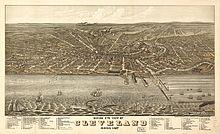
In 1836, the city, then located only on the eastern banks of the Cuyahoga River, nearly erupted into open warfare with neighboring Ohio City over a bridge connecting the two. Ohio City remained an independent municipality until its annexation by Cleveland in 1854.
The city's prime geographic location as transportation hub on the Great Lakes has played an important role in its development as a commercial center. Cleveland serves as a destination point for iron ore shipped from Minnesota, as well as coal transported by rail. In 1870, John D. Rockefeller founded Standard Oil in Cleveland, and moved its headquarters to New York City in 1885. Cleveland emerged in the early 20th Century as an important American manufacturing center, which included automotive companies such as Peerless, People's, Jordan, and Winton, maker of the first car driven across the U.S. Other manufacturers located in Cleveland produced steam-powered cars, which included White and Gaeth, as well as the electric car company Baker. By 1920, due in large part to the city's economic prosperity, Cleveland became the nation's fifth largest city. The city counted Progressive Era politicians such as the populist Mayor Tom L. Johnson among its leaders. Many prominent Clevelanders from this era are buried in the historic Lake View Cemetery, including President James A. Garfield, and John D. Rockefeller.
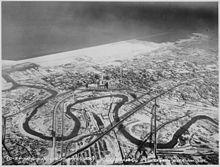
In commemoration of the centennial of Cleveland's incorporation as a city, the Great Lakes Exposition debuted in June 1936 along the Lake Erie shore north of downtown. Conceived as a way to energize a city after the Great Depression, it drew four million visitors in its first season, and seven million by the end of its second and final season in September 1937. The exposition was housed on grounds that are now used by the Great Lakes Science Center, the Rock and Roll Hall of Fame and Burke Lakefront Airport, among others. Following World War II, the city experienced a prosperous economy. In sports, the Indians won the 1948 World Series and the Browns dominated professional football in the 1950s. Businesses proclaimed that Cleveland was the "best location in the nation". In 1940, non-Hispanic whites represented 90.2% of Cleveland's population. The city's population reached its peak of 914,808, and in 1949 Cleveland was named an All-America City for the first time. By the 1960s, the economy slowed, and residents sought new housing in the suburbs, reflecting the national trends of urban flight and suburban growth.
During the African-American Civil Rights Movement of the 1950s and 1960s, social unrest occurred in Cleveland, resulting in the Hough Riots from July 18, 1966 ae July 23, 1966 and the Glenville Shootout from July 23, 1968 ae July 25, 1968. In December 1978, Cleveland became the first major American city to enter into a financial default on federal loans since the Great Depression. Suburbanization changed the city in the late 1960s and 1970s, when financial difficulties and a notorious 1969 fire on the Cuyahoga River challenged the city. This, along with the city's struggling professional sports teams, drew negative national press; as a result, Cleveland was often derided as "The Mistake on the Lake".
By the beginning of the 1980s, several factors, including changes in international free trade policies, inflation and the Savings and Loans Crisis contributed to the recession that impacted cities like Cleveland. While unemployment during the period peaked in 1983, Cleveland's rate of 13.8% was higher than the national average due to the closure of several production centers.

The metropolitan area began a gradual economic recovery under Mayors George Voinovich and Michael R. White. Redevelopment within the city limits has been strongest in the downtown area near the Gateway complex aeconsisting of Progressive Field and Quicken Loans Arena, and near North Coast Harbor aeincluding the Rock and Roll Hall of Fame, Cleveland Browns Stadium, and the Great Lakes Science Center. Cleveland has been hailed by local media as the "Comeback City," while economic development of the inner-city neighborhoods and improvement of the school systems are municipal priorities. In 1999, Cleveland was identified as an emerging global city.
In the 21st century, the city has improved infrastructure, is more diversified, and has invested in the arts. Cleveland is generally considered an example of revitalization. In studies conducted by The Economist in 2005 Cleveland was ranked as one of the most livable cities in the United States, and the city was ranked as the best city for business meetings in the continental U.S. The city's goals include additional neighborhood revitalization and increased funding for public education.

According to the United States Census Bureau, the city has a total area of 82.4 square miles (213.4 km2), of which, 77.6 square miles (201.0 km2) is land and 4.8 square miles (12.4 km2) is water. The total area is 5.87% water. The shore of Lake Erie is 569 feet (173 m) above sea level; however, the city lies on a series of irregular bluffs lying roughly parallel to the lake. In Cleveland these bluffs are cut principally by the Cuyahoga River, Big Creek, and Euclid Creek. The land rises quickly from the lakeshore. Public Square, less than a mile (2 km) inland, sits at an elevation of 650 feet (198 m), and Hopkins Airport, only 5 miles (8 km) inland from the lake, is at an elevation of 791 feet (241 m).
Due to the moderating effects of Lake Erie, Cleveland exhibits a humid subtropical climate (Koppen climate classification Cfa). However, surrounding areas that experience slightly cooler wintertime conditions are generally classified as a humid continental climate. The city has warm, humid summers and cold, snowy winters. The Lake Erie shoreline is very close to due east-west from the mouth of the Cuyahoga west to Sandusky, but at the mouth of the Cuyahoga it turns sharply northeast. This feature is the principal contributor to the lake effect snow that is typical in Cleveland (especially on the city's East Side) from mid-November until the surface of Lake Erie freezes, usually in late January or early February. The lake effect also causes a relative differential in geographical snowfall totals across the city: while Hopkins Airport, on the city's far West Side, has only reached 100 inches (254 cm) of snowfall in a season three times since 1968, seasonal totals approaching or exceeding 100 inches (254 cm) are not uncommon as the city ascends into the Heights on the east, where the region known as the 'Snow Belt' begins. Extending from the city's East Side and its suburbs, the Snow Belt up the Lake Erie shore as far as Buffalo.
The all-time record high in Cleveland of 104 °F (40 °C) was established on June 25, 1988, and the all-time record low of na20 °F ( na29 °C) was set on January 19, 1994. On average, July is the warmest month with a mean temperature of 73.5 °F (23.1 °C), and January, with a mean temperature of 28.1 °F ( na2.2 °C), is the coldest. Normal yearly precipitation based on the 30-year average from 1981 to 2010 is 39.14 inches (994 mm). The least precipitation occurs on the western side and directly along the lake, and the most occurs in the eastern suburbs. Parts of Geauga County receive over 44 inches of liquid precipitation annually.
Occasionally, severe thunderstorms strike Cleveland bringing with them the threat of large hail, damaging winds and tornadoes. The threat is greatest during spring and early summer.

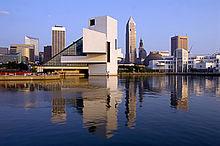
Cleveland's downtown architecture is diverse. Many of the city's government and civic buildings, including City Hall, the Cuyahoga County Courthouse, the Cleveland Public Library, and Public Auditorium, are clustered around an open mall and share a common neoclassical architecture. Built in the early 20th century, they are the result of the 1903 Group Plan, and constitute one of the most complete examples of City Beautiful design in the United States. The Terminal Tower, dedicated in 1930, was the tallest building in North America outside New York City until 1964 and the tallest in the city until 1991. It is a prototypical Beaux-Arts skyscraper. The two newer skyscrapers on Public Square, Key Tower (currently the tallest building in Ohio) and the 200 Public Square, combine elements of Art Deco architecture with postmodern designs. Another of Cleveland's architectural treasures is The Arcade (sometimes called the Old Arcade), a five-story arcade built in 1890 and renovated in 2001 as a Hyatt Regency Hotel. Cleveland's landmark ecclesiastical architecture includes the historic Old Stone Church in downtown Cleveland and the onion domed St. Theodosius Russian Orthodox Cathedral in Tremont, along with myriad ethnically inspired Roman Catholic churches.
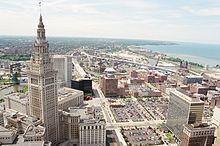
Running east from Public Square through University Circle is Euclid Avenue, which was known for its prestige and elegance. In the late 1880s, writer Bayard Taylor described it as "the most beautiful street in the world." Known as "Millionaire's Row", Euclid Avenue was world-renowned as the home of such internationally known names as Rockefeller, Hanna, and Hay.
Cleveland is home to four of the parks in the countywide Cleveland Metroparks system, as well as the: Washington Park, Brookside Park and parts of the Rocky River and Washington Reservations. Known locally as the "Emerald Necklace", the Olmsted-inspired Metroparks encircle Cuyahoga county. Included in the system is the Cleveland Metroparks Zoo. Located in Big Creek valley, the zoo contains one of the largest collection of primates in North America. In addition to the Metroparks system, the Cleveland Lakefront State Park district provides public access to Lake Erie. This cooperative between the City of Cleveland and the State of Ohio contains six parks: Edgewater Park, located on the city's near west side between the Shoreway and the lake; East 55th Street Marina, Euclid Beach Park and Gordon Park. The Cleveland Public Parks District is the municipal body that oversees the city's neighborhood parks, the largest of which is the historic Rockefeller Park, notable for its late-19th century historical landmark bridges and Cultural Gardens.
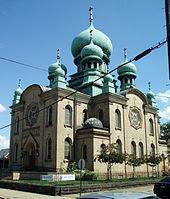
Downtown Cleveland is centered around Public Square and includes a wide range of diversified districts. Downtown Cleveland is home to the traditional Financial District and Civic Center, as well as the distinct Theater District, which is home to Playhouse Square Center. Mixed-use neighborhoods such as the Flats and the Warehouse District are occupied by industrial and office buildings as well as restaurants and bars. The number of downtown housing units in the form of condominiums, lofts, and apartments has been on the increase since 2000. Recent developments include the revival of the Flats, the Euclid Corridor Project, and the developments along East 4th Street.
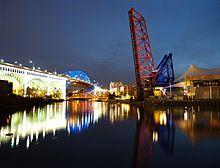
Cleveland residents geographically define themselves in terms of whether they live on the east or west side of the Cuyahoga River. The east side includes the neighborhoods of Buckeye-Shaker, Central, Collinwood, Corlett, Euclid-Green, Fairfax, Forest Hills, Glenville, Payne/Goodrich-Kirtland Park, Hough, Kinsman, Lee Harvard/Seville-Miles, Mount Pleasant, Nottingham, St. Clair-Superior, Union-Miles Park, University Circle, Little Italy, and Woodland Hills. The west side includes the neighborhoods of Brooklyn Centre, Clark-Fulton, Detroit-Shoreway, Cudell, Edgewater, Ohio City, Tremont, Old Brooklyn, Stockyards, West Boulevard, and the four neighborhoods colloquially known as West Park: Kamm's Corners, Jefferson, Puritas-Longmead, and Riverside. Three neighborhoods in the Cuyahoga Valley are sometimes referred to as the south side: Industrial Valley/Duck Island, Slavic Village (North and South Broadway), and Tremont.
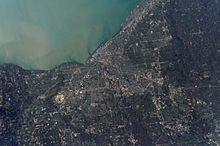
Several inner-city neighborhoods have begun to gentrify in recent years. Areas on both the west side (Ohio City, Tremont, Detroit-Shoreway, and Edgewater) and the east side (Collinwood, Hough, Fairfax, and Little Italy) have been successful in attracting increasing numbers of creative class members, which in turn is spurring new residential development. Furthermore, a live-work zoning overlay for the city's near east side has facilitated the transformation of old industrial buildings into loft spaces for artists.
Cleveland's older, inner-ring suburbs include Bedford, Bedford Heights, Brook Park, Brooklyn, Brooklyn Heights, Cleveland Heights, Cuyahoga Heights, East Cleveland, Euclid, Fairview Park, Garfield Heights, Lakewood, Linndale, Maple Heights, Newburgh Heights, Parma, Parma Heights, Shaker Heights, South Euclid, University Heights, and Warrensville Heights. Many are members of the Northeast Ohio First Suburbs Consortium.
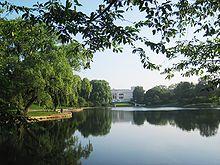
Cleveland is home to Playhouse Square Center, the second largest performing arts center in the United States behind New York's Lincoln Center. Playhouse Square includes the State, Palace, Allen, Hanna, and Ohio theaters within what is known as the Theater District of Downtown Cleveland. Playhouse Square's resident performing arts companies include Cleveland Play House, Opera Cleveland, Cleveland State University Department of Theatre and Dance, and Great Lakes Theater Festival. The center hosts various Broadway musicals, special concerts, speaking engagements, and other events throughout the year.
One Playhouse Square, now the headquarters for Cleveland's public broadcasters, was originally used as the broadcast studios of WJW (AM), where disc jockey Alan Freed first popularized the term "rock and roll". Located between Playhouse Square and University Circle is the and Karamu House, a well-known African American performing and fine arts center, founded in the 1920s.
Cleveland is home to the Cleveland Orchestra, widely considered one of the finest orchestras in the world, and often referred to as the finest in the United States. It is one of the "Big Five" major orchestras in the United States. The Orchestra plays at Severance Hall in University Circle during the winter and at Blossom Music Center in Cuyahoga Falls during the summer. The city is also home to the Cleveland Pops Orchestra.
There are two main art museums in Cleveland. The Cleveland Museum of Art is a major American art museum, with a collection that includes more than 40,000 works of art ranging over 6,000 years, from ancient masterpieces to contemporary pieces. Museum of Contemporary Art Cleveland showcases established and emerging artists, particularly from the Cleveland area, through hosting and producing temporary exhibitions.
The Gordon Square Arts District on Detroit Road, in the Detroit-Shoreway neighborhood, features a movie theater called the Capitol Theatre and an off-off-Broadway playhouse, the Cleveland Public Theatre.
Cleveland has served as the setting for several major studio and independent films. Players from the 1948 Cleveland Indians, winners of the World Series, appear in The Kid from Cleveland (1949). Cleveland Municipal Stadium features prominently in both that film and The Fortune Cookie (1966); written and directed by Billy Wilder, the picture marked Walter Matthau and Jack Lemmon's first on-screen collaboration and features gameday footage of the 1965 Cleveland Browns. Director Jules Dassin's first American film in nearly twenty years, Up Tight! (1968) is set in Cleveland of April 1968 immediately following the assassination of Martin Luther King, Jr. Set in 1930s Cleveland, Sylvester Stallone stars as a warehouse worker who leads the local labor union in F.I.S.T. (1978). Paul Simon chose Cleveland as the opening for his first and only venture into filmmaking, One-Trick Pony (1980); Simon spent six weeks filming concert scenes at the Cleveland Agora. The boxing-match-turned-riot near the start of Raging Bull (1980) takes place at the Cleveland Arena in 1941. Clevelander Jim Jarmusch's critically acclaimed and independently-produced Stranger Than Paradise (1984) ae a deadpan comedy about two New Yorkers who travel to Florida by way of Cleveland ae was a favorite of the Cannes Film Festival, winning the Camera d'Or. The cult-classic mockumentary This Is Spinal Tap (1984) includes a memorable scene where the parody band gets lost backstage just before performing at a Cleveland rock concert (origin of the phrase "Hello, Cleveland!"). Howard the Duck (1986), George Lucas' heavily-criticized adaptation of the Marvel comic of the same name, begins with the title character crashing into Cleveland after drifting in outer space. Michael J. Fox and Joan Jett play the sibling leads of a Cleveland rock group in Light of Day (1987); directed by Paul Schrader, much of the film was shot in the city. Both Major League (1989) and Major League II (1994) reflected the actual perennial struggles of the Cleveland Indians during the 1960s, 70s, and 80s. Kevin Bacon stars in Telling Lies in America (1997), the semi-autobiographical tale of Clevelander Joe Eszterhas, a former reporter for The Plain Dealer. Cleveland serves as the setting for fictitious insurance giant Great Benefit in The Rainmaker (1997); in the film, Key Tower doubles as the firm's main headquarters. A group of Cleveland teenagers try to scam their way into a Kiss concert in Detroit Rock City (1999), and several key scenes from director Cameron Crowe's Almost Famous (2000) are set in Cleveland. Antwone Fisher (2002) recounts the real-life story of the Cleveland native. Brothers Joe and Anthony Russo ae native Clevelanders and Case Western Reserve University alumni ae filmed their comedy Welcome to Collinwood (2002) entirely on location in the city. American Splendor (2003) ae the biopic of Harvey Pekar, author of the autobiographical comic of the same name ae was also filmed on location throughout Cleveland, as was The Oh in Ohio (2006). Much of The Rocker (2008) is set in the city, and Cleveland native Nathaniel Ayers' life story is told in The Soloist (2009). Kill the Irishman (2011) follows the real-life turf war in 1970s Cleveland between Irish mobster Danny Greene and the Italian mafia. Most recently, the modern day teenage comedy Fun Size (2012) takes place in and around Cleveland on Halloween night.
Cleveland has also doubled for other locations in film. The wedding and reception scenes in The Deer Hunter (1978), while set in the small Pittsburgh suburb of Clairton, were actually shot in the Cleveland neighborhood of Tremont; U.S. Steel also permitted the production to film in one of its Cleveland mills. Francis Ford Coppola produced The Escape Artist (1982), much of which was shot in Downtown Cleveland near City Hall and the Cuyahoga County Courthouse, as well as the Flats. A Christmas Story (1983) was set in Indiana, but drew many of its external shots ae including the Parker family home ae from Cleveland. Double Dragon (1994) filmed in an abandoned warehouse along Cleveland's Lake Erie shoreline, the Flats along the Cuyahoga River and Tower City Center. Much of Happy Gilmore (1996) was also shot in Cleveland, and the opening shots of Air Force One (1997) were filmed in and above Severance Hall. More recently, a complex chase and battle scene in Spider-Man 3 (2007), though set in New York City, was actually filmed along Cleveland's Euclid Avenue. Downtown's East 9th Street also doubled for New York in the climactic end sequence of The Avengers (2012); in addition, the production shot on Cleveland's Public Square as a fill-in for Stuttgart, Germany. The Greater Cleveland Film Commission works to bring future productions to the Cleveland area.
In television, the city is well known as the setting for the popular network sitcom The Drew Carey Show starring Cleveland native Drew Carey. Currently host of The Price Is Right and formerly the host of Whose Line Is It Anyway?, Carey joins three other Cleveland natives who have hosted prominent national shows ae talk show pioneer Phil Donahue, former late night host Arsenio Hall, and Family Feud host Steve Harvey, who also starred in the network sitcom The Steve Harvey Show. Winner of the premiere season of The Next Iron Chef, Cleveland chef Michael Symon regularly appears on the Food Network, while Crime 360 follows real-life homicide detectives in Cleveland and other U.S. cities. Hot in Cleveland, a comedy airing on TV Land, premiered on June 16, 2010.
The American modernist poet Hart Crane was born in nearby Garrettsville, Ohio in 1899. His adolescence was divided between Cleveland and Akron before moving to New York City, finally in 1916. Aside from factory work during the first world war, he served as reporter to The Plain Dealer for a short period, before achieving recognition in the Modernist literary scene. A diminutive memorial park is dedicated to Crane along the left bank of the Cuyahoga in Cleveland.
Langston Hughes, preeminent poet of the Harlem Renaissance and child of an itinerant couple, attended high school in Cleveland in the 1910s.
Cleveland was the home of Joe Shuster and Jerry Siegel, who created the comic book character Superman in 1932. Both attended Glenville High School, and their early collaborations resulted in the creation of "The Man of Steel". D. A. Levy wrote : "Cleveland: The Rectal Eye Visions". Mystery author Richard Montanari's first three novels, Deviant Way, The Violet Hour, and Kiss of Evil are set in Cleveland. Mystery writer, Les Roberts's Milan Jacovich series is also set in Cleveland.
Harlan Ellison, noted author of speculative fiction, was born in Cleveland in 1934; his family subsequently moved to the nearby suburb of Painesville, though Ellison moved back to Cleveland in 1949. As a youngster, he published a series of short stories appearing in the Cleveland News; he also performed in a number of productions for the Cleveland Play House.
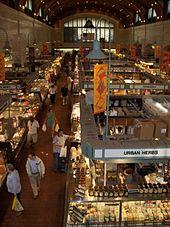
Cleveland's melting pot of immigrant groups and their various culinary traditions have long played an important role in defining the local cuisine. Examples of these can particularly be found in neighborhoods such as Little Italy, Slavic Village, and Tremont.
Local mainstays of Cleveland's cuisine include an abundance of Central and Eastern European contributions, such as kielbasa, stuffed cabbage and pierogies. Cleveland also has plenty of corned beef, with nationally renowned Slyman's, on the near East Side, a perennial winner of various accolades from Esquire Magazine, including being named the best corned beef sandwich in America in 2008. Other famed sandwiches include the Cleveland original, Polish Boy, a local favorite found at many BBQ and Soul food restaurants. With its blue-collar roots well intact, and plenty of Lake Erie perch available, the tradition of Friday night fish fries remains alive and thriving in Cleveland, particularly in the church-based settings. The award-winning Great Lakes Brewing Company (located across the street from the historic West Side Market), offers several locally styled beers and ales.
Cleveland is noted in the world of haute cuisine. Famous local figures include chef Michael Symon and food writer Michael Ruhlman, both of whom achieved local and national attentions for their contributions in the culinary world. On November 11, 2007, Symon helped gain the spotlight when he was named "The Next Iron Chef" on the Food Network. In 2007, Ruhlman collaborated with Anthony Bourdain, to do an entire episode of his Anthony Bourdain: No Reservations focusing on Cleveland's restaurant scene.
The national food press ae including publications Gourmet, Food & Wine, Esquire and Playboy ae has heaped praise on several Cleveland spots for awards including 'best new restaurant', 'best steakhouse', 'best farm-to-table programs' and 'great new neighborhood eateries'. In early 2008, the Chicago Tribune ran a feature article in its 'Travel' section proclaiming Cleveland, America's "hot new dining city".
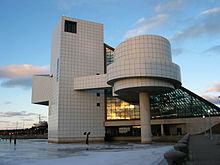
Five miles (8 km) east of downtown Cleveland is University Circle, a 550-acre (2.2 km2) concentration of cultural, educational, and medical institutions, including the Cleveland Botanical Garden, Case Western Reserve University, University Hospitals, Severance Hall, the Cleveland Museum of Art, the Cleveland Museum of Natural History, and the Western Reserve Historical Society. A 2011 study by Walk Score ranked Cleveland 17th most walkable of fifty largest U.S. cities. Cleveland is home to the I. M. Pei-designed Rock and Roll Hall of Fame, located on the Lake Erie waterfront at North Coast Harbor downtown. Neighboring attractions include Cleveland Browns Stadium, the Great Lakes Science Center, the Steamship Mather Museum, and the USS Cod, a World War II submarine. Cleveland has an attraction for visitors and fans of A Christmas Story, A Christmas Story House and Museum to see props, costumes, rooms, photos and everything referenced to a yuletide film classic from the mind of Jean Shepherd. Cleveland is home to many festivals throughout the year. Cultural festivals such as the annual Feast of the Assumption in the Little Italy neighborhood, the Harvest Festival in the Slavic Village neighborhood, and the more recent Cleveland Asian Festival in the Asia Town neighborhood are popular events. Vendors at the West Side Market in Ohio City offer many different ethnic foods for sale. Cleveland hosts an annual parade on Saint Patrick's Day that brings hundreds of thousands to the streets of downtown.
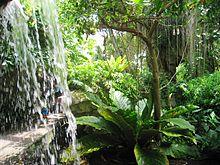
Fashion Week Cleveland, the city's annual fashion event, is one of the few internationally recognized fashion industry happenings in North America. The show is considered by many to be the best in the Midwest aeperhaps second only to New York for fashion weeks in the US. In addition to the cultural festivals, Cleveland hosted the CMJ Rock Hall Music Fest, which featured national and local acts, including both established artists and up-and-coming acts, but the festival was discontinued in 2007 due to financial and manpower costs to the Rock Hall. The annual Ingenuity Fest, Notacon and TEDxCLE conference focus on the combination of art and technology. The Cleveland International Film Festival has been held annually since 1977, and it drew a record 66,476 people in March 2009. Cleveland also hosts an annual holiday display lighting and celebration, dubbed Winterfest, which is held downtown at the city's historic hub, Public Square.
Cleveland also has the Horseshoe Casino Cleveland. Phase I opened on May 14, 2012 on Public Square, in the historic former Higbee's Building at Tower City Center. Phase II will open along the bend of the Cuyahoga River behind Tower City Center.
The new Greater Cleveland Aquarium is located on the west bank of the Cuyahoga River near Downtown.
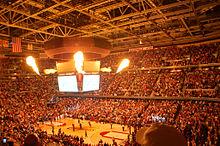
Cleveland's professional sports teams include the Cleveland Indians (Major League Baseball), Cleveland Browns (National Football League), Cleveland Cavaliers (National Basketball Association), Lake Erie Monsters (American Hockey League), the Cleveland Gladiators (Arena Football League), and the Cleveland Crush (Lingerie Football League). Local sporting facilities include Progressive Field, Cleveland Browns Stadium, Quicken Loans Arena and the Wolstein Center.
The Indians last reached the World Series in 1997, losing to the Florida Marlins, and have not won the series since 1948. Between 1995 and 2001, Progressive Field (then known as Jacobs Field) sold out 455 consecutive games, a Major League Baseball record until it was broken in 2008. The Cavs won the Eastern Conference in 2007, but were defeated in the NBA Finals by the San Antonio Spurs. Although the Browns are historically among the winningest franchises in the NFL, the team has not won a championship since 1964.

The city's failure to win a trophy in any major professional sport since 1964 has earned it a reputation of being a cursed sports city, which ESPN validated by proclaiming Cleveland as its "most tortured sports city" in 2004. In addition, changes in the Cleveland sports landscape have led to further heartbreak and resentment among local fans, the most notable instances being Art Modell's relocation of the Browns to Baltimore after the 1995 season (that franchise became the Ravens, with the current Browns team starting play in 1999), and Akron native LeBron James' decision to leave the Cavaliers in 2010 for the Miami Heat.
A notable Cleveland athlete is Jesse Owens, who grew up in the city after moving from Alabama when he was nine. He participated in the 1936 Summer Olympics in Berlin, where he achieved international fame by winning four gold medals: one each in the 100 meters, the 200 meters, the long jump, and as part of the 4 x 100 meter relay team.
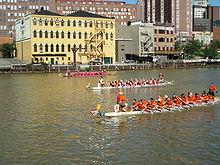
Cleveland facilities have hosted the Major League Baseball All-Star Game five times, the NBA All-Star Game twice, and the United States Figure Skating Championships four times. The city hosted the Gravity Games, an extreme sports series, from 2002 to 2004, and the Dew Action Sports Tour Right Guard Open in 2007. Cleveland will host the 2014 Gay Games.
The city has been home to several additional professional sports franchises, including a women's basketball team and multiple soccer teams. Cleveland has also been home to several ice hockey franchises, beginning in 1937 with the AHL member Cleveland Barons.[100] The original Barons, although having been the most successful team in AHL history at that point, moved to Jacksonville, Florida, where they subsequently folded after one season.[101] The salient cause of the Baron's move came from Nick Mileti's short-lived WHA franchise, the Cleveland Crusaders, which shared the old Cleveland Arena with the Barons in beginning in 1972.[102] The new league ultimately created a financial disparity that the Barons could not compete with.[103] Local philanthropist George Gund III facilitated the relocation of the NHL's California Golden Seals to Cleveland in 1976 and renamed them the Barons. However, this latest incarnation was short lived, with the team merging with the Minnesota North Stars following the 1977 ae78 season.[103] In 1992 the Cleveland Lumberjacks of the (also now-defunct) IHL began play, lasting until 2001. Later in 2001, a third incarnation of the Barons was established, this time having returned to the AHL. The Barons moved to Worcester, Massachusetts following the 2006 season.
In 1997 Cleveland was awarded one of the original eight franchises in the WNBA, the Cleveland Rockers.[104] Although the Rockers finished first in the WNBA Eastern Conference on two occasions, they never made an appearance in the WNBA Finals. The team folded in 2003 after the league was unable to find a new owner. Previous owner Gordon Gund had dropped the team from operation, citing financial losses and poor attendance.[105]
From 1978 to 1988, Cleveland was home to the Cleveland Force of the MISL. After the Force folded in 1988 they were replaced by the Cleveland Crunch of the NPSL and MISL, who played from 1989 to 2005. The Crunch won three league championships in the 1990s, being the first Cleveland sports team to win a championship since the 1964 Cleveland Browns. They re-adopted the Force name in 2002 before ceasing operations in 2005.
Outdoor soccer has also been represented in Cleveland via the Cleveland Cobras (1972-Cleveland Stars, 1973 ae1981 Cobras) of the ASL and the Cleveland Stokers (1967 ae1968) of the North American Soccer League
The Cleveland City Stars played in the United Soccer Leagues from 2006 to 2009, winning the USL Second Division championship in 2008 before folding after the 2009 season.
The headquarters of the Mid-American Conference (MAC) are located in Cleveland. The conference also stages both its men's and women's basketball tournaments at Quicken Loans Arena.
The Cleveland State Vikings men's and women's basketball teams play their home games at the Wolstein Center. The university is considering forming a non-scholarship Division I FCS football program.[106][107][108]
Cleveland's sole remaining daily newspaper is The Plain Dealer. Previous major newspapers in Cleveland include the afternoon newspaper, the Cleveland Press, which printed its last edition on June 17, 1982, and the Cleveland News, which ceased publication in 1960. Additional newspaper coverage includes the Thursdays-only Sun Post-Herald and Parma Sun Post, which serve a few neighborhoods on the city's west side.[109] The city is also served by Cleveland Magazine, a regional culture magazine published monthly; Crain's Cleveland Business, a weekly business newspaper; Cleveland Jewish News, a weekly Jewish newspaper;[110] and Cleveland Scene, a free alternative weekly paper which absorbed its competitor, the Cleveland Free Times, in 2008. In addition, nationally-distributed rock magazine Alternative Press was founded in Cleveland in 1985, and the publication's headquarters remain based in the city.[111]
Combined with nearby Akron and Canton, Cleveland is ranked as the 18th-largest television market by Nielsen Media Research (as of 2009 ae10).[112] The market is served by 10 stations affiliated with major American networks including: WEWS-TV (ABC), WJW (Fox), WKYC (NBC), WOIO (CBS), WVIZ (PBS), WBNX-TV (The CW), WUAB (MNTV), WVPX-TV (ION), WQHS-DT (Univision), and WDLI-TV (TBN). The Mike Douglas Show, a nationally-syndicated daytime talk show, began in Cleveland in 1961 on KYW-TV (now WKYC),[113] while The Morning Exchange on WEWS-TV served as the model for Good Morning America.[114] Tim Conway and Ernie Anderson first established themselves in Cleveland while working together at KYW-TV and later WJW-TV (now WJW). Anderson, the father of director Paul Thomas Anderson, both created and performed as the immensely popular Cleveland horror host Ghoulardi on WJW-TV's Shock Theater.[115]
Cleveland is served directly by 31 AM and FM radio stations, 22 of which are licensed to the city; numerous other stations are heard from elsewhere in Northeast Ohio.[116] News/talk station WTAM serves as the AM flagship of Cleveland's three major professional sports teams (the Browns, Cavaliers, and Indians), and as such, is frequently among the highest rated stations.[117][118][119] Commercial FM music stations consistently round out the rest of Arbitron's top-ten: WDOK, WQAL (adult contemporary); WMJI (classic hits); WGAR-FM (country); WENZ, WZAK (hip-hop/R&B); WAKS (pop); W256BT, WLFM-LP, WMMS, WNCX (rock); and WHLK (variety hits).[119] WCPN public radio functions as the local NPR affiliate, and WCLV is one of the few remaining commercial classical stations in the country.[120] Cleveland's first FM sports station, WKRK-FM serves as the flagship for the Cleveland Gladiators.[121][122] WKNR covers sports via ESPN Radio, and functions as the flagship for the Lake Erie Monsters; as WJW (AM), the station was once the home of Alan Freed ae the Cleveland disc-jockey credited with first using and popularizing the term "rock and roll" to describe the music genre.[123][124] News/talk station WHK was the 15th radio station in the United States and the first in Ohio; its former sister station, rock station WMMS (formerly WHK-FM), dominated Cleveland radio in the 1970s and 80s and was at that time one of the highest rated radio stations in the country.[125][126] In 1972, WMMS Program Director Billy Bass coined the phrase "The Rock 'n' Roll Capital of the World" to describe Cleveland. In 1987, Playboy named WMMS DJ Kid Leo (Lawrence Travagliante) "The Best Disc Jockey in the Country".[127]
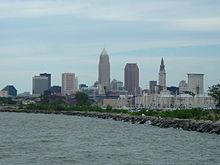
Cleveland's geographic location on the Cuyahoga River and Lake Erie has been key to its growth. The Ohio and Erie Canal coupled with rail links helped establish the city as an important business center. Steel and many other manufactured goods emerged as leading industries.[128]
The city diversified its economy in addition to its manufacturing sector. Cleveland is home to the corporate headquarters of many large companies such as Applied Industrial Technologies, Eaton, Forest City Enterprises, Sherwin-Williams Company and KeyCorp. NASA maintains a facility in Cleveland, the Glenn Research Center. Jones Day, one of the largest law firms in the U.S, began in Cleveland.[129] Cleveland and its surrounding suburbs are also home to several private equity firms including The Riverside Company, Kirtland Capital Partners, Resilience Capital Partners and Primus Capital.[130]
The Duke Realty Corp. is one of the area's largest landlords and holds a large office building portfolio in the southern suburbs.[131][132] In 2007, Cleveland's commercial real estate market experienced rebound with a record pace of purchases,[133][134] with a housing vacancy of ten percent.[135][136]
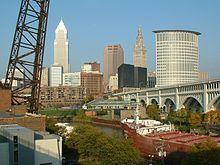
The Cleveland Clinic is the city's largest private employer with a workforce of over 37,000.[137] It carries the distinction as being among America's best hospitals with top ratings published in U.S. News & World Report[138] Cleveland's healthcare sector includes University Hospitals of Cleveland, a renowned center for cancer treatment,[139] and MetroHealth medical center. Cleveland is also noted in the fields of biotechnology and fuel cell research, led by Case Western Reserve University, the Cleveland Clinic, and University Hospitals of Cleveland. Cleveland is among the top recipients of investment for biotech start-ups and research.[140] Case Western Reserve, the Clinic, and University Hospitals have recently announced plans to build a large biotechnology research center and incubator on the site of the former Mt. Sinai Medical Center, creating a research campus to stimulate biotech startup companies that can be spun off from research conducted in the city.[141]
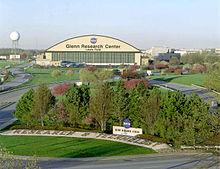
City leaders stepped up efforts to grow the technology sector in the first decade of the 21st century. Former Mayor Jane L. Campbell appointed a "tech czar" whose job is to actively recruit tech companies to the downtown office market, offering connections to the high-speed fiber networks that run underneath downtown streets in several "high-tech offices" focused on the Euclid Avenue area. Cleveland State University hired a Technology Transfer Officer to work full time on cultivating technology transfers from CSU research to marketable ideas and companies in the Cleveland area, and appointed a Vice President for Economic Development to leverage the university's assets in expanding the city's economy. Case Western Reserve University participates in technology initiatives such as the OneCommunity project,[142] a high-speed fiber optic network linking the area's major research centers intended to stimulate growth. OneCommunity's work attracted the attention of Intel and in mid-2005, Cleveland was named an Intel "Worldwide Digital Community" along with Corpus Christi, Texas, Philadelphia, Pennsylvania, and Taipei, Taiwan. This distinction added about $12 million for marketing to expand regional technology partnerships, create a city-wide WiFi network, and develop a tech economy. In addition to this Intel initiative, in January 2006 a New York aebased think tank, the Intelligent Community Forum, selected Cleveland as the sole American city among its seven finalists for the "Intelligent Community of the Year" award. The group announced that it nominated the city for its OneCommunity network with potential broadband applications.[143] The OneCommunity Network is collaborating with Cisco Systems to deploy a cutting-edge wireless network that could provide widespread access to the region. Cisco is testing new technologies in wireless "mesh" networking. OneCommunity and Cisco officially launched the first phase in September 2006, blanketing several square miles of University Circle with wireless connectivity.[144]
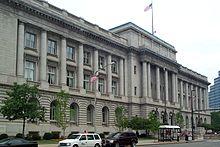
Cleveland's position as a center of manufacturing established it as a hotbed of union activity early in its history. While other parts of Ohio, particularly Cincinnati and the southern portion of the state, have historically supported the Republican Party, Cleveland commonly breeds the strongest support in the state for the Democrats;[145] At the local level, elections are nonpartisan. However, Democrats still dominate every level of government. Cleveland is split between two congressional districts. Most of the western part of the city is in the 10th District, represented by Dennis Kucinich. Most of the eastern part of the city, as well as most of downtown, is in the 11th District, represented by Marcia Fudge. Both are Democrats. During the 2004 Presidential election, although George W. Bush carried Ohio by 2.1%, John Kerry carried Cuyahoga County 66.6% ae32.9%,[146] his largest margin in any Ohio county. The city of Cleveland supported Kerry over Bush by the even larger margin of 83.3% ae15.8%.[147] The city of Cleveland operates on the mayor-council (strong mayor) form of government.[148] The mayor is the chief executive of the city, and the office is held in 2010 by Frank G. Jackson. Previous mayors of Cleveland include progressive Democrat Tom L. Johnson, World War I era War Secretary and founder of Baker Hostetler law firm Newton D. Baker, United States Supreme Court Justice Harold Hitz Burton, Republican Senator George V. Voinovich, two-term Ohio Governor and Senator, current Representative Dennis Kucinich of Ohio's 10th district, Frank J. Lausche, and Carl B. Stokes, the first African American mayor of a major American city.[149] The state of Ohio lost two Congressional seats as a result of the 2010 Census which effects Cleveland's districts in the northeast part of the state.[150]
Based on the Morgan Quitno Press 2008 national crime rankings, Cleveland ranked as the 7th most dangerous city in the nation among US cities with a population of 100,000 to 500,000 and the 11th most dangerous overall.[151] Violent crime from 2005 to 2006 was mostly unchanged nationwide, but increased more than 10% in Cleveland. The murder rate dropped 30% in Cleveland, but was still far above the national average. Property crime from 2005 to 2006 was virtually unchanged across the country and in Cleveland, with larceny-theft down by 7% but burglaries up almost 14%.[152]
In October 2010, Cleveland had two neighborhoods appear on ABC News's list of 'America's 25 Most Dangerous Neighborhoods': both in sections just blocks apart in the city's Central neighborhood on the East Side. Ranked 21st was in the vicinity of Quincy Avenue and E.40th Streets, while an area near E. 55th and Scovill Avenue ranked 2nd in the nation, just behind a section of the East Garfield Park neighborhood in Chicago, which ranked 1st.[153][154]
A study in 1971 ae72 found that although Cleveland's crime rate was significantly lower than other large urban areas, most Cleveland residents feared crime.[155] In the 1980s, gang activity was on the rise, associated with crack cocaine. A task force was formed and was partially successful at reducing gang activity by a combination of removing gang-related graffiti and educating news sources to not name gangs in news reporting.[156]
The distribution of crime in Cleveland is highly heterogeneous. Relatively few crimes take place in downtown Cleveland's business district, but the perception of crime in the downtown has been pointed to by the Greater Cleveland Growth Association[157] as damaging to the city's economy.[158] More affluent areas of Cleveland and its suburbs have lower rates of violent crime than areas of lower socioeconomic status. Statistically speaking, higher incidences of violent crimes have been noted in some parts of Cleveland with with higher populations of African Americans, although the causes of these crimes are complex and ambiguous.[159] A study of the relationship between employment access and crime in Cleveland found a strong inverse relationship, with the highest crime rates in areas of the city that had the lowest access to jobs. Furthermore, this relationship was found to be strongest with respect to economic crimes.[160] A study of public housing in Cleveland found that criminals tend to live in areas of higher affluence and move into areas of lower affluence to commit crimes.[161]
Cleveland is protected by the paid firefighters of the Cleveland Division of Fire.[162] The department currently operates out of 27 fire stations in six battalions under the command of six battalion chiefs and one assistant chief per shift.[163] The Division of Fire operates a fire apparatus fleet of 23 engine companies, ten ladder companies, three tower companies, four rescue squad companies, one tactical rescue company, one fireboat, one technical rescue unit, and numerous other special, support, and reserve units. The current chief is Timothy O'Toole.
According to the 2010 Census, Cleveland had 53.3% African American, 37.3% White (33.4% Non-Hispanic Whites), 0.3% Native American, 1.8% Asian American, 0.0% Native Hawaiian and other Pacific Islander, 4.5% of some other race, and 2.8% from two or more races. Hispanic and Latino Americans of any race accounted for 10.0% of its population, with Puerto Ricans being the majority of the group.[167][168]
As of the 2000 Census, there were 478,403 people, 190,638 households, and 111,904 families residing in the city. The population density was 6,166.5 people per square mile (2,380.9/km ²). There were 215,856 housing units at an average density of 2,782.4 per square mile (1,074.3/km ²). Ethnic groups include Germans (9.2%), Irish (8.2%), Poles (4.8%), Italians (4.6%), and English (2.8%).[169] There are also substantial communities of Slovaks, Hungarians, French, Slovenes,[170] Czechs, Ukrainians, Arabs, Dutch, Scottish, Russian, Scotch Irish, Croats,[171] Puerto Ricans, West Indians, Romanians, Lithuanians, and Greeks.[169] The presence of Hungarians within Cleveland proper was, at one time, so great that the city boasted the highest concentration of Hungarians in the world outside of Budapest.[172] The availability of jobs attracted African Americans from the South. Between 1920 and 1960, the black population of Cleveland increased from 35,000 to 251,000.[173]
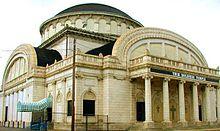
Out of 190,638 households, 29.9% have children under the age of 18 living with them, 28.5% were married couples living together, 24.8% had a female householder with no husband present, and 41.3% were nonfamilies. 35.2% of all households were made up of individuals and 11.1% had someone living alone who is 65 years of age or older. The average household size was 2.44 and the average family size was 3.19. The population was spread out with 28.5% under the age of 18, 9.5% from 18 to 24, 30.4% from 25 to 44, 19.0% from 45 to 64, and 12.5% who are 65 years of age or older. The median age was 33 years. For every 100 females there were 90.0 males. For every 100 females age 18 and over, there were 85.2 males. The median income for a household in the city was $25,928, and the median income for a family was $30,286. Males had a median income of $30,610 versus $24,214 for females. The per capita income for the city was $14,291. 26.3% of the population and 22.9% of families were below the poverty line. Out of the total population, 37.6% of those under the age of 18 and 16.8% of those 65 and older were living below the poverty line.
The Cleveland Metropolitan School District is the largest K ae12 district in the state of Ohio, with 127 schools and an enrollment of 55,567 students during the 2006 ae2007 academic year.[174] It is the only district in Ohio that is under direct control of the mayor, who appoints a school board.[175]
Approximately 1 square mile (2.6 km2) of Cleveland, adjacent the Shaker Square neighborhood, is part of the Shaker Heights City School District. The area, which has been a part of the Shaker school district since the 1920s, permits these Cleveland residents to pay the same school taxes as the Shaker residents, as well as vote in the Shaker school board elections.[176]
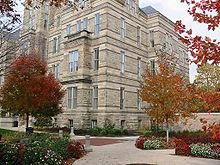
Cleveland is home to a number of colleges and universities. Most prominent among these is Case Western Reserve University, a world-renowned research and teaching institution located in University Circle. A private university with several prominent graduate programs, Case was ranked 37th in the nation in 2012 by U.S. News & World Report.[178] University Circle also contains Cleveland Institute of Art and the Cleveland Institute of Music. Cleveland State University (CSU), based in Downtown Cleveland, is the city's public four-year university. In addition to CSU, downtown hosts the metropolitan campus of Cuyahoga Community College, the county's two-year higher education institution. Ohio Technical College is based in Cleveland.[179]
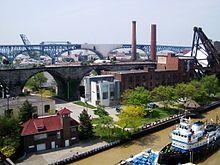
Cleveland Hopkins International Airport is the city's major airport and an international airport that serves as one of the ten main hubs for United Airlines. It holds the distinction of having the first airport-to-downtown rapid transit connection in North America, established in 1968. In 1930, the airport was the site of the first airfield lighting system and the first air traffic control tower. Originally known as Cleveland Municipal Airport, it was the first municipally owned airport in the country. Cleveland Hopkins is a significant regional air freight hub hosting FedEx Express, UPS Airlines, United States Postal Service, and major commercial freight carriers. In addition to Hopkins, Cleveland is served by Burke Lakefront Airport, on the north shore of downtown between Lake Erie and the Shoreway. Burke is primarily a commuter and business airport.[180]
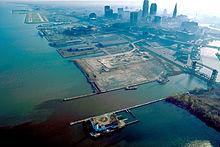
The Port of Cleveland, located at the Cuyahoga River's mouth, is a major bulk freight terminal on Lake Erie, receiving much of the raw materials used by the region's manufacturing industries.[181]
Amtrak, the national passenger rail system, provides service to Cleveland, via the Capitol Limited and Lake Shore Limited routes, which stop at Cleveland Lakefront Station. Cleveland has also been identified as a hub for the proposed Ohio Hub project, which would bring high-speed rail to Ohio.[182] Cleveland hosts several inter-modal freight railroad terminals.[183][184] There have been several proposals for commuter rail in Cleveland, including an ongoing (as of January 2011[185]) study into a Sandusky aeCleveland line.[186]
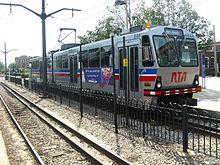
Cleveland has a bus and rail mass transit system operated by the Greater Cleveland Regional Transit Authority (RTA). The rail portion is officially called the RTA Rapid Transit, but local residents refer to it as The Rapid. It consists of two light rail lines, known as the Green and Blue Lines, and a heavy rail line, the Red Line. In 2008, RTA completed the HealthLine, a bus rapid transit line, for which naming rights were purchased by the Cleveland Clinic and University Hospitals. It runs along Euclid Avenue from downtown through University Circle, ending at the Louis Stokes Station at Windermere in East Cleveland.[187] In 2007, the American Public Transportation Association named Cleveland's mass transit system the best in North America.[188]
National intercity bus service is provided at a Greyhound station, located just behind the Playhouse Square theater district. Megabus provides service to Cleveland and has a stop outside of Tower City Center in downtown Cleveland.[189] Lakefront Trailways provides regional inter-city bus service to popular destinations from their terminal south of Cleveland in Brook Park.[190] Akron Metro, Brunswick Transit Alternative, Laketran, Lorain County Transit, and Medina County Transit provide connecting bus service to the Greater Cleveland Regional Transit Authority. Geauga County Transit and Portage Area Regional Transportation Authority (PARTA) also offer connecting bus service in their neighboring areas.[191]
Cleveland's road system consists of numbered streets running roughly north-south, and named avenues, which run roughly east-west. The numbered streets are designated "east" or "west", depending where they lie in relation to Ontario Street, which bisects Public Square.[192] The numbered street system extends beyond the city limits into some suburbs on both the west and east sides. The named avenues that lie both on the east side of the Cuyahoga River and west of Ontario Street receive a "west" designation on street signage. The two downtown avenues which span the Cuyahoga change names on the west side of the river. Superior Avenue becomes Detroit Avenue on the west side, and Carnegie Avenue becomes Lorain Avenue. The bridges that make these connections are often called the Detroit aeSuperior Bridge and the Lorain aeCarnegie Bridge.
Three two-digit Interstate highways serve Cleveland directly. Interstate 71 begins just southwest of downtown and is the major route from downtown Cleveland to the airport. I-71 runs through the southwestern suburbs and eventually connects Cleveland with Columbus and Cincinnati. Interstate 77 begins in downtown Cleveland and runs almost due south through the southern suburbs. I-77 sees the least traffic of the three interstates, although it does connect Cleveland to Akron. Interstate 90 connects the two sides of Cleveland, and is the northern terminus for both I-71 and I-77. Running due east aewest through the west side suburbs, I-90 turns northeast at the junction with and I-490, and is known as the Innerbelt through downtown. At the junction with the Shoreway, I-90 makes a 90-degree turn known in the area as Dead Man's Curve, then continues northeast, entering Lake County near the eastern split with Ohio State Route 2. Cleveland is also served by two three-digit interstates, Interstate 480, which enters Cleveland briefly at a few points and Interstate 490, which connects I-77 with the junction of I-90 and I-71 just south of downtown.[193]
Two other limited-access highways serve Cleveland. The Cleveland Memorial Shoreway carries State Route 2 along its length, and at varying points also carries US 6, US 20 and I-90. The Jennings Freeway (State Route 176) connects I-71 just south of I-90 to I-480 near the suburbs of Parma and Brooklyn Heights. A third highway, the Berea Freeway (State Route 237 in part), connects I-71 to the airport, and forms part of the boundary between Cleveland and Brook Park.[194]
Cleveland has twenty-two sister cities:[195]

Word Count: 9605





